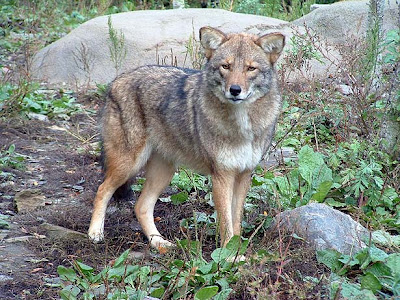Sometimes, the name we call a thing is the key that shapes our knowledge of it. In Nova Scotia, that is very true of the animal we call the Eastern coyote. That name carries baggage from cartoons and the old west of a scrawny scavenger. It would be more accurate if we used the name it has in parts of Ontario and the USA. There, some people call it a coywolf.
From the mid-twentieth century on, this animal undertook a complicated eastward migration, filling habitat left vacant by a near-relative, the red wolf, whose bloodline goes directly back about 700,000 years to the ancestor of all wolves. When what started as a coyote reached our coast, it showed a hefty dose of wolf genes. The nature of the beast had been changed,
The history of wolves is complicated and hotly debated, but the red wolf provides the link. This was what the first Europeans encountered, smaller than the grey wolf and occupying the hardwood lands east of the Mississippi and south of the Canadian Shield. By the 1980s, hunting, trapping, poisoning, and fire had wiped it out in the wild. It was re-introduced to several preserves, with limited success only in North Carolina..
Somewhere between ancestral wolf and red wolf, two things happened. The western family branch evolved to suit the habitat and became coyote. Meanwhile, primitive wolves crossed the Bering land bridge to Eurasia and developed into the wolves known there. Later, some returned, larger and of a different colour, to become the grey wolves of our north,
As the coyote travelled east, it would have met both wolf species. The last remnants of the red wolf, its close relative, it interbred with. Grey wolves normally kill coyotes, but somehow, according to some scientists, the genes still got mixed in.
To make things even more complicated, Ontario’s Algonquin National Park has wolves that may not be part of any of the other species. They are called the Eastern wolf. There’s a scientific tiff ongoing about whether they are an offshoot of the red wolf or a separate sub-species.
In any case, some or all of these wolves beefed up the coyote. By the time it hit the Atlantic coast, it was no longer the 14 kilogram plains scavenger. The new version often weighs 20 kilograms or more and tests done in Maine show some to be genetically as much wolf as coyote.
More changed than just size. From the Western coyote, a tolerance for humans and their habitations was inherited, but hunting habits became wolf-like. While the western coyote is a loner, wolves hunt in packs. So does this newcomer. I’ve seen a group of them drive a deer onto February lake ice so they could pull it down.
You may call that an Eastern coyote act if you wish. I prefer coywolf.
The larger, highly adaptable animals "have the wolf characteristics of pack hunting and aggression and the coyote characteristics of lack of fear of human-developed areas," says Trent University geneticist Bradley White, who's been studying the hybrids for 12 years.
(from The Toronto Star)
|








No comments:
Post a Comment